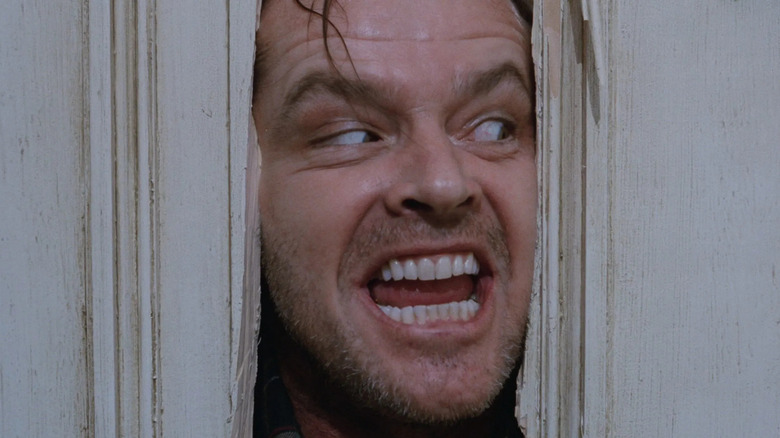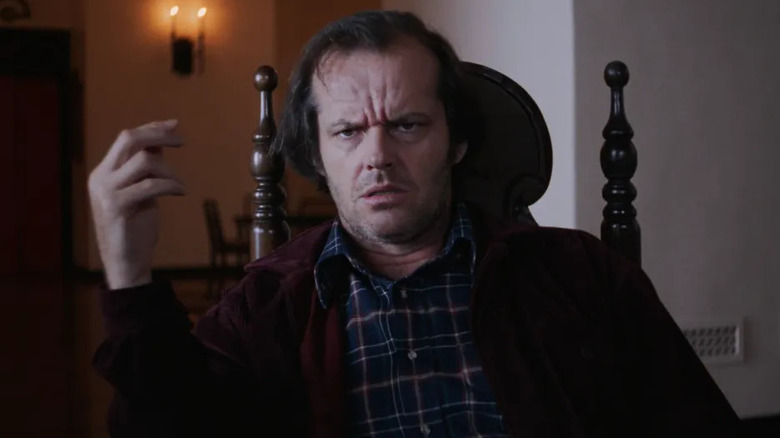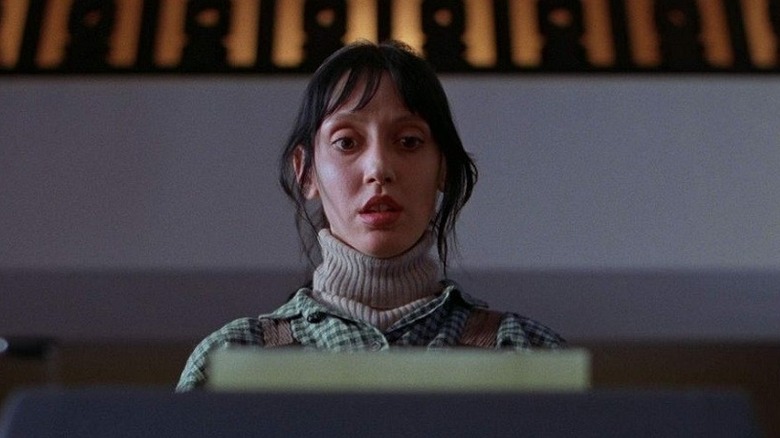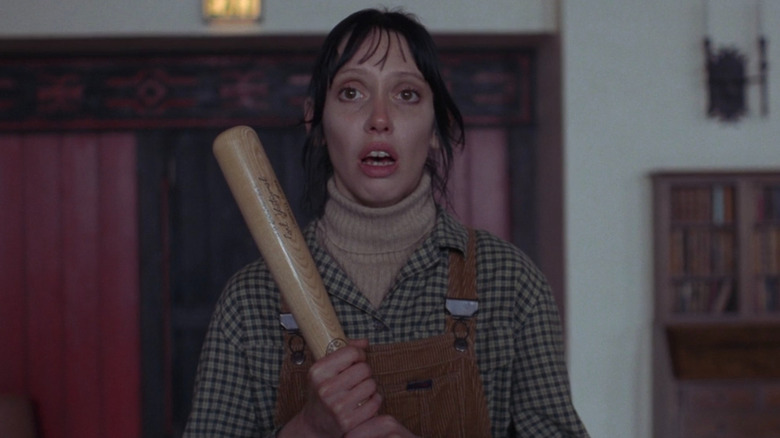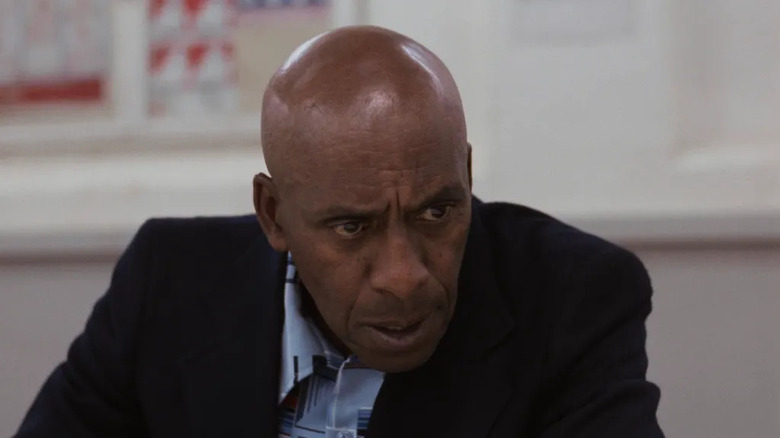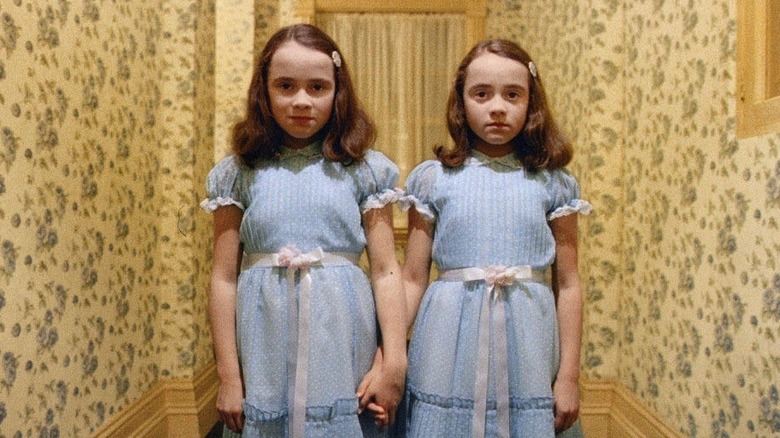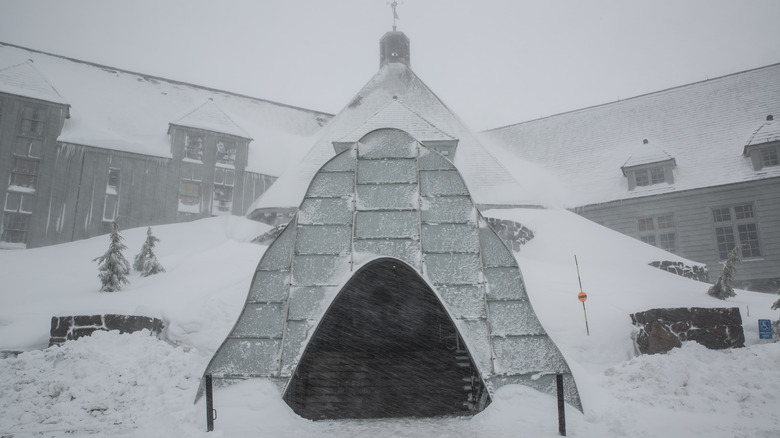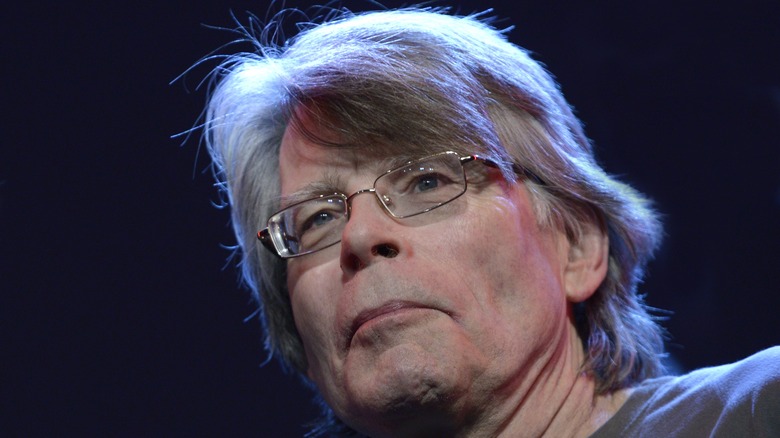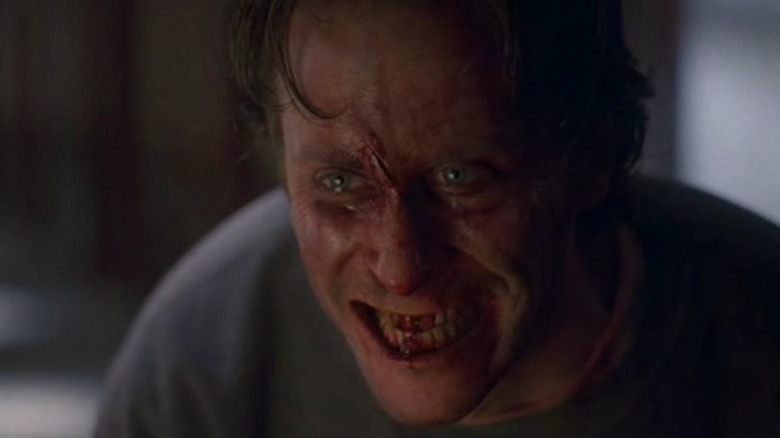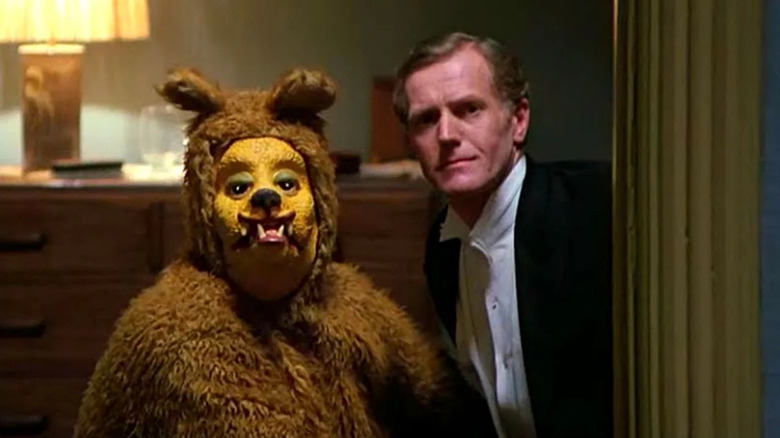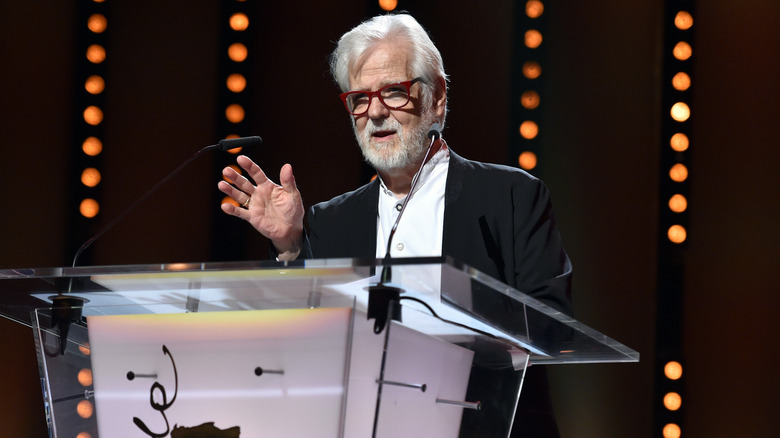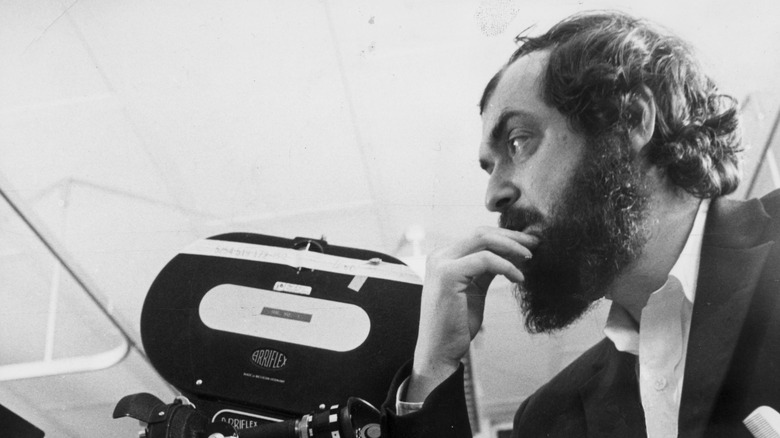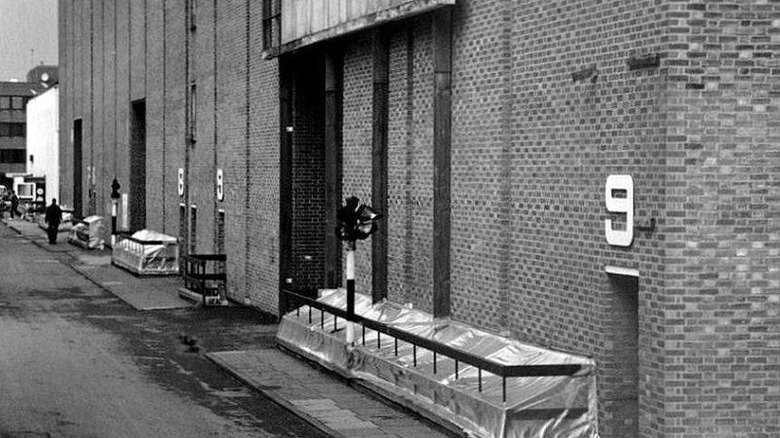The Untold Truth Of The Shining
Stephen King published his third novel, "The Shining," in 1977 and just three years later, legendary director Stanley Kubrick adapted it into a film. While both works are classics, they are also very different from each other. Kubrick and King had several fundamental disagreements on the concepts of ghosts, hell, and horror in general, so the film version of "The Shining" became its own creation without many ties to what inspired it (via TCM).
The main focus of the book is on the ability of undead beings to corrupt mortals into committing acts of evil, which did not seem to interest Kubrick for his vision for the film. According to Entertainment Weekly, when crew members asked Kubrick questions about the movie, he would respond, "I never explain anything, I don't understand it myself. It's a ghost film!"
Kubrick's take on "The Shining" has much less to do with the corrupting desires of ghosts, since it focuses predominately on the very visceral terror of a deranged Jack Torrance rampaging through the halls with an axe. So, unlike in the book, the intentions of the evil spirits and reasons for Jack's psychotic break in the film are vague (to say the least). There's an almost Lovecraftian layer of the unknown in the horror of the film, which isn't felt in the novel. This fear of the unknown is just one of the film's many mysterious qualities that has caused fans to incessantly theorize about what exactly is happening in a movie by one of Hollywood's most fascinating directors. Luckily, there are some things that we do know about the history of Kubrick's film, so grab your key to room 237 and let's unlock the untold truth of "The Shining."
Several other actors were considered before Jack Nicholson
After watching Stanley Kubrick's creepy adaptation of "The Shining," it's probably hard for most to imagine anyone other than Jack Nicholson in the role of Jack Torrance. For the depiction of a man teetering on the verge of madness into a full-blown breakdown, Nicholson was an excellent casting decision. However, the legendary actor was far from the only choice for the role.
In his book, "Fright Favorites," David J. Skal says that Stephen King rejected several options that Kubrick proposed for the lead, including Robert De Niro, Robin Williams, and Harrison Ford. King was more of a fan of having someone like Jon Voight or Michael Moriarty play the role instead. But according to Kubrick's Twitter, none of them were really at the top of the director's list, since he preferred Nicholson for the part.
King eventually accepted Nicholson as Jack Torrance, although he wound up regretting that decision later, primarily because he criticized how Kubrick wanted the character portrayed. In an interview with Deadline, King says, "the character of Jack Torrance has no arc in that movie. Absolutely no arc at all," and then adds, "he's crazy ... All he does is get crazier. In the book, he's a guy who's struggling with his sanity and finally loses it. To me, that's a tragedy." Many fans may not see Nicholson's iconic portrayal as a "tragedy," but it's hard not to wonder what Jack may have looked like in the hands of Robin Williams or Harrison Ford.
Jessica Lange was almost cast as Wendy Torrance
Stephen King not only disliked how Jack Torrance was portrayed in the film but was actually even more upset with Wendy Torrance in the adaptation. In an interview with the BBC, he says the portrayal "is one of the most misogynistic characters ever put on film," adding, "She's basically just there to scream and be stupid, and that's not the woman that I wrote about."
The author wanted the character to be shown as the strong woman that he initially wrote, and envisioned Jessica Lange as someone who could do so (via The Mirror). Jack Nicholson also agreed that she would be great for the part after he read the novel (via Lewton Bus). In the end, Kubrick went in a completely different direction and dramatically changed the character to represent someone more anxious and fragile. For this version of the story, the director felt Shelley Duvall was a better fit for the part.
Stanley Kubrick made Shelley Duvall go through hell
Kubrick's vision of Wendy Torrance illustrates a woman who is in such an abusive relationship that she's too frightened to leave, which is a difficult reality that many people face. But significantly more disturbing is the lengths that Kubrick was willing to go to get his desired performance out of Shelley Duvall, which made filming quite a harrowing experience for the 28-year-old actress that would have significant long-term effects on her.
In an interview with Dr. Phil many years later, Duvall is seen as still traumatized by the year spent on set. She admits, "that film was hell to be a part of," and goes on to say, "if he hadn't directed the way he did, if he hadn't done everything with force and cruelty, then I guess it wouldn't have turned out to be as it was" (via The Mirror).
Not only was the cast and crew ordered to ignore and isolate Duvall, but Kubrick also punished her as much as possible. One of the worst examples of this is when she was forced to do 127 takes of the scene where she holds the baseball bat, as Jack Nicholson slowly stalks towards her. Hours of crying on camera left her dehydrated and hoarse, and her hands even bled from holding the bat so tightly and for long. Kubrick's daughter, Vivian, shot behind-the-scenes footage for "Making the Shining," which features various moments of tension between Duvall and Kubrick, and even shows Duvall's hair falling out due to the unbearable stress of filming.
If you or someone you know is dealing with domestic abuse, you can call the National Domestic Violence Hotline at 1−800−799−7233. You can also find more information, resources, and support at their website.
It won a Guinness World Record for number of retakes of a scene
Filming "The Shining" may not have been as hard for the rest of the cast and crew as it was for Duvall, but it was still extremely difficult. The number of takes Kubrick wanted to shoot for every scene and the numerous changes to the script increased the shooting schedule from six months to over a year. Due to the daily rewrites, Jack Nicholson reportedly gave up memorizing the script and instead would just do a quick study of the scene prior to filming (via Novel Suspects).
While Shelly Duvall had to endure seemingly endless torturous retakes of holding the baseball bat, 70-year-old Scatman Crothers (who played Dick Hallorann) also suffered due to Kubrick's perfectionism. Kubrick demanded 60 retakes for one scene, which made Crothers cry in exasperation (via The Guardian). Yet none of these were as high as the "shine" scene, whose 148 retakes earned it the Guinness World Record for most retakes for one scene with dialogue.
However, there were some in the crew who didn't mind all of the retakes. In an interview with The Independent, cinematographer Garrett Brown says, "I realized on day one it was a priceless opportunity for me to perfect what I was doing, really to learn the physical act of doing it," Brown recalls. "I could have literally done 100 takes or 1,000 takes."
It was the last film for the child actors
If the experience of filming "The Shining" was so tough for many of the adults, it must have been grueling for the child actors ... or so we might think. In an interview with The Guardian, Danny Lloyd — who plays Danny Torrance — describes how Kubrick did what he could to protect him from the scary aspects of "The Shining," so he wouldn't be scarred for life. In fact, Kubrick was so successful that Lloyd didn't even know he was in a horror film and not a drama until years later. In spite of the endless retakes of various scenes, Lloyd has spoken positively about his experience on "The Shining." But he struggled to find success after the film, and quit acting when he was 13 or 14. However, Lloyd wasn't the only child actor of "The Shining" to make that decision.
Lisa and Louise burns played the creepy and iconic Grady twins, who terrified audiences with their great performance. In spite of their success on screen, they decided to focus on academic pursuits rather than careers in film. Years later, the pair appeared in an episode of VH1's "Where Are They Now," where they described their decidedly less creepy lives out of the spotlight: Louise works as an IT manager at a help desk, while Lisa negotiates licenses for intellectual property.
The Overlook Hotel was inspired by the Stanley Hotel
One of the key features shared by both the novel and the film is the eerie atmosphere of the Overlook Hotel. And while the iconic hotel is a fictional location, it is actually based upon the Stanley Hotel in Estes, Colorado. In late September 1974, Stephen King and his wife spent time at the Stanley Hotel when it was nearly empty, as the resort was about to close for winter. The silent halls and spooky ambience creeped the author out so much that it led to a nightmare that would become the origin for "The Shining."
On his website, King writes, "That night I dreamed of my three-year-old son running through the corridors, looking back over his shoulder, eyes wide, screaming. He was being chased by a fire-hose. I woke up with a tremendous jerk, sweating all over, within an inch of falling out of bed. I got up, lit a cigarette, sat in the chair looking out the window at the Rockies, and by the time the cigarette was done, I had the bones of the book firmly set in my mind."
The author is not the only one to think he might have encountered something supernatural at the hotel, which has a long history of being haunted. Since the novel and film showcased the resort in such an unforgettable fashion, the owners and staff have leaned into the image of the Stanley as a haunted hotel and used it as a marketing strategy (via The New York Times). In 2015, the Stanley Hotel gave the people what they wanted and decided to add the hedge maze that Kubrick created for his film.
Stephen King was not pleased with the film
While King's novel and Kubrick's film are both great works of fiction, they really are in some ways separate entities, particularly since Kubrick decided to make "The Shining" his own. Since its release, King has expressed criticisms of the film that boil down to his frustration over the various changes from his original version.
In the interview with Deadline, King says, "I think 'The Shining' is a beautiful film and it looks terrific and as I've said before, it's like a big, beautiful Cadillac with no engine inside it. In that sense, when it opened, a lot of the reviews weren't very favorable, and I was one of those reviewers. I kept my mouth shut at the time, but I didn't care for it much."
King's intent was for the audience to care about and sympathize the characters, including the increasingly more dangerous Jack. So, along with his disappointment with how both Jack and Wendy Torrance are portrayed in the movie, King also has a problem with the feeling that in Kubrick's hands, the overall story is darker and more heartless than what he envisioned (via TCM). He sums it up as such: "I always thought that the real difference between my take on it and Stanley Kubrick's take on it was this: In my novel, the hotel burns. In Kubrick's movie, the hotel freezes. It's the difference between warmth and cold" (via TCM).
The 1997 miniseries was much truer to the novel
20 years after the release of his novel, King got his chance to redeem his original story and tell it the way he wanted to for television audiences. "The Shining" miniseries was written and produced by the horror master, and then aired on ABC in three parts in 1997 (via Game Rant).
Directed by Mick Garris and featuring Steven Weber and Rebecca De Mornay as Jack and Wendy, the small screen adaptation shows the characters in a way that is more true to how they are written in the novel. Not only does De Mornay play a much stronger character, but it is also clear in Weber's portrayal of Jack that the evil influence of the undead at the Overlook is the main cause of his descent into madness.
Made-for-TV horror series are always more limited in what they can depict or the themes they can dive into due to the restrictions of broadcast television networks. So, in many ways, it is unfair to compare the miniseries with the classic film, which had more freedom to explore the book's darkness and horror. In spite of these limitations, the TV miniseries still got a number of positive reviews by critics, and it even won two Emmy awards for Makeup and Sound Editing.
There's a possible darker meaning of the bear suit scene
Note that discussions of child abuse follow.
While there are many hard-to-believe conspiracy theories about the film's secret messages, most of these interpretations do have quite in-depth reasoning to back them up. One such theory is also one of the darkest, which is put forward in a thorough analysis by film scholar Rob Ager in his book, "Mazes, Mirrors, Deception and Denial." Ager makes the argument that there is a horrific, secret meaning behind the disturbing bear suit scene, which would also explain why there were slight changes from the event as it is written in the novel.
In the book, a man in a dog costume performs a sexual act on another man, but in the film, he is dressed as a bear instead. Bears are a recurring motif in Kubrick's film and in fact, their image is associated with Danny several times in the movie: Danny lays down on a large bear pillow at the therapist's office, there's a picture of bears above his bed in the hotel, and we see a prominent bear skin rug in the lobby.
Ager notes that the use of this bear imagery connects Danny to the man in the bear costume, which speaks to a much darker and more sinister subtext: Danny has been sexually abused by Jack. Ager points to other evidence of this potential trauma, such as the Playgirl issue that Jack is reading, which features a story with the title "Incest: Why parents sleep with their children." There's also the similar use of a mirror between Danny's dream sequence in room 237 where Jack meets the rotting old woman (whom Ager argues is a manifestation of Jack himself) and the "fatherly love" scene with Danny. While Ager's interpretation is his own, he does make a powerful case for this reading of Jack as a man and father, which makes him even more of a monster than he already is.
If you or someone you know may be the victim of child abuse, please contact the Childhelp National Child Abuse Hotline at 1-800-4-A-Child (1-800-422-4453) or contact their live chat services.
Jan Harlan claims there are no serious messages in the film
Along with interpretations of the bear suit mystery, there are many other theories of hidden meanings throughout the film. One of the more notable examples is that the film is an allegory of the genocide of the American Indians (via The Washington Post). Since Kubrick rarely gave interviews about his movies, both fans and theorists have run wild with their explanations of almost every shot. Kubrick was a well-known perfectionist, so when even a minor detail is off, many are quick to find some logical reason for the discrepancy.
But producer Jan Harlan is very clear about what he thinks about the conspiracy theories surrounding the film. In an interview with Entertainment Weekly, he says, "It's not a movie with a serious message. I know many people think it's impossible that Kubrick did a film which didn't have serious messages and an enormous amount of [theories have been] invented. While he was alive all that was relatively quiet. After his death, these [theories] came out which were funny, and partly insulting."
The producer also addressed one of the worst theories about secret meanings: "The most insulting one is the idea that 'The Shining' is a film about the Holocaust. That's outrageous. That's an insult to Kubrick, that he would deal with the most serious crime in human history in such a light way, and also an insult to victims of the Holocaust. The other ideas are much more harmless, where continuity mistakes are attributed with deep meaning." It's difficult to argue with Harlan on this, since Kubrick actually did want to make a film about the Holocaust, and spent over 20 years developing a project called "The Aryan Papers," which never came to fruition (via The Independent).
Major scenes and an alternate ending were cut
One condition that Kubrick made Warner Bros. agree to was that all unused footage had to be destroyed. As producer Jan Harlan tells Entertainment Weekly, "Stanley wanted to make sure that nobody would ever re-assemble his edit in any other way. All outtakes and unused scenes were systematically destroyed — including negatives and rushes. He himself knew that he would never consider a re-cut. He was someone who lived totally in the present. He never looked back."
Among the unused takes were two scenes with key plot points, which would have changed the ending of the story if they were not deleted. The first shows Jack finding a scrapbook that illustrates the dark events of the Overlook's past. Even though the scene did not make the final cut, the scrapbook can still be seen on his desk for a moment later in the film because it was so important to the story. As a result, the very end, which shows the photograph of Jack from 1921, makes even less sense without that cut scene.
Kubrick also took out an alternate ending because Warner Bros. thought the movie was too long. After Jack's famous demise in the cold, the scene shows Wendy and Danny safe in a hospital. The manager of the Overlook Hotel tells them that an investigation was done and no evidence of paranormal activity has been found, which makes the audience question everything that's just happened. But then, he hands Danny the same tennis ball the boy found outside the haunted Room 237, leaving the audience without a doubt of the supernatural events just witnessed, but also wondering about him: Is he a ghost or not? Ultimately, this playing with the audience's emotions proved to be too confusing, so Kubrick allowed the scene to be cut.
The Elstree set caught fire near the end of production
As if the filming of "The Shining" could not get any more chaotic, things took an even more intense turn when a fire broke out at Elstree Studios — where the majority of the film was shot — near the end of production (via The Independent). Luckily, no one was harmed, but the flames caused all sorts of damage and even set bottles of Scatman Crothers' Brut aftershave on fire, which gave the destruction a sweet scent.
Kubrick not only seemed unfazed, but was even a bit happy about the disaster. In an interview with BBC, his widow Christiane Kubrick says, "It gave him a long delay, which for some reason he thought was quite fun cause he could rethink certain things." She then adds, "He was quite dizzy with what now he could do because he could think about it and rewrite this, and rewrite that." Ray Merrin, the sound editor, also comments on how the director only seemed concerned with making sure his audio recordings were safe. Kubrick's nonchalant attitude would probably have been much different if the polystyrene snow had caught fire too, which could have potentially lead to cases of poisoning on set and throughout the surrounding community. Luckily, the combustible material had been stored in the backlot at the time.
